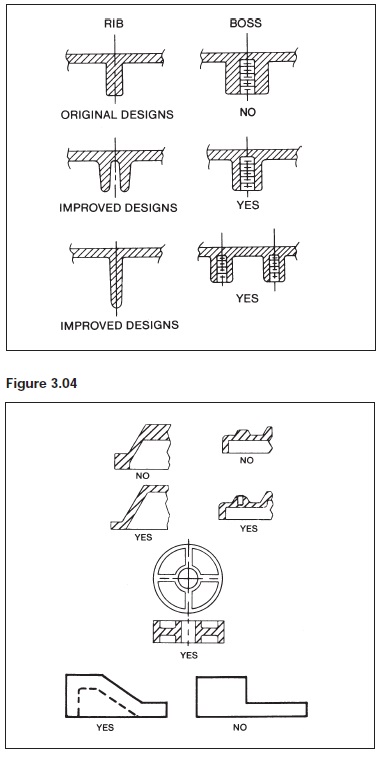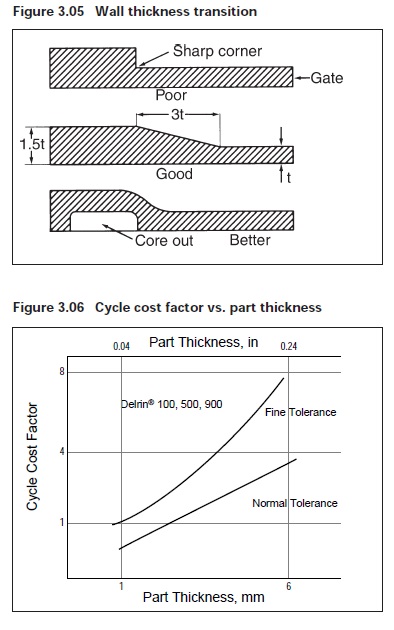WALL THICKNESS
Cost savings are highest when components have a minimum wall thickness, as long as that thickness is consistentwith the part’s function and meets all mold filling considerations. As would be expected, parts cool faster with thin wall thicknesses, which means that cycle times are shorter, resulting in more parts per hour. Further, thin parts weigh less, using less plastic per part. On average, the wall thickness of an injection molded part ranges from 2mm to 4mm (.080 inch to .160 inch). Thin wall injection molding can produce walls as thin as .05mm (.020 inch).
UNIFORM WALLS
Parts with walls of uniform thickness allow the mold cavity to fill more easily since the molten plastic does not have to be forced through varying restrictions as it fills.
If the walls are not uniform the thin section cools first, then as the thick section cools and shrinks it builds stresses near the boundary area between the two. Because the thin section has already hardened, it doesn’t yield. As the thick section yields, it leads to warping or twisting of the part, which, if severe enough, can cause cracks.

Shrinkage is caused by intersecting walls of non-uniform wall thickness. Examples of these are ribs, bosses, and other projections of the nominal wall. If these projections have greater wall thicknesses, they will solidify slower. The region where they are attached to the nominal wall will shrink along with the projection, resulting in a sink in the nominal wall.Shrink can be minimized by maintaining rib thicknesses to 50 to 60% of the walls they are attached to.
Bosses located at corners can result in very thick walls causing sinks. Bosses can be isolated using the techniques illustrated.

Links: Article link.
What if you cannot have uniform walls (due to design limitations)?
If design limitations make it impossible to have uniform wall thicknesses, the change in thickness should be as gradual as possible.
Coring is a method where plastic is removed from the thick area, which helps to keep wall sections uniform, eliminating the problem altogether.
Gussets are support structures that can be designed into the part to reduce the possibility of warping.
Uniform Walls.
Uniform wall thickness in plastic part design is
critical. Non-uniform wall thickness can cause serious
warpage and dimensional control problems. If greater
strength or stiffness is required, it is more economical
to use ribs than increase wall thickness. In parts
requiring good surface appearance, ribs should be
avoided as sink marks on the opposite surface will
surely appear. If ribbing is necessary on such a part,
the sink mark is often hidden by some design detail on
the surface of the part where the sink mark appears,
such as an opposing rib, textured surface, etc.
Even when uniform wall thickness is intended, attention
to detail must be exercised to avoid inadvertent
heavy sections, which can not only cause sink marks,
but also voids and non-uniform shrinkage. For example,
a simple structural angle (Figure 3.01) with a
sharp outside corner and a properly filleted inside
corner could present problems due to the increased
wall thickness at the corner. To achieve uniform
wall thickness use an external radius as shown in
Figure 3.02.
Figure 3.01 Effects of non-uniform wall thickness on
molded parts
 Configurations
Configurations
Other methods for designing uniform wall thickness
are shown in Figures 3.03 and 3.04. Obviously there
are many options available to the design engineer to
avoid potential problems. Coring is another method
used to attain uniform wall thickness. Figure 3.04
shows how coring improves the design. Where
different wall thicknesses cannot be avoided, the
designer should effect a gradual transition from one
thickness to another as abrupt changes tend to increase
the stress. Further, if possible, the mold should be
gated at the heavier section to insure proper packing
(see Figure 3.05).
Figures 3.03
As a general rule, use the minimum wall thickness that
will provide satisfactory end-use performance of the
part. Thin wall sections solidify (cool) faster than
thick sections. Figure 3.06 shows the effect of wall
thickness on production rate.




